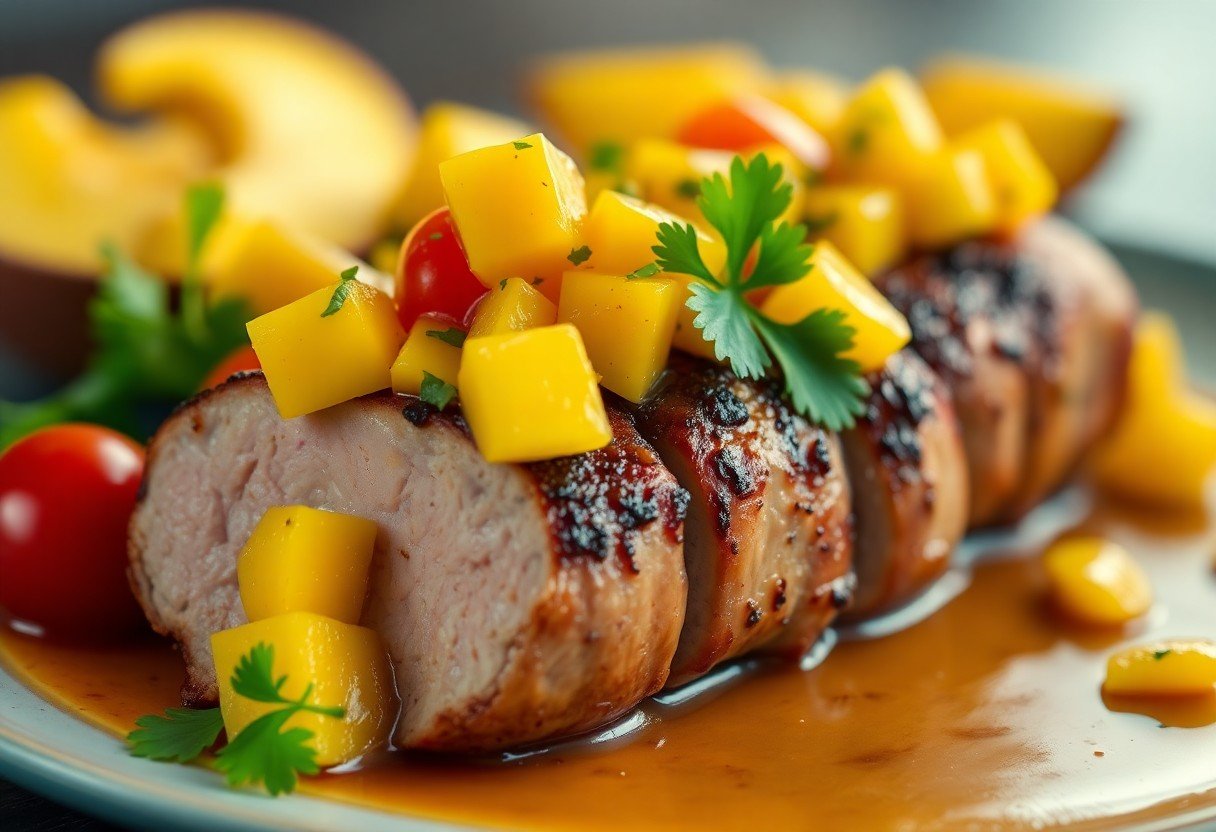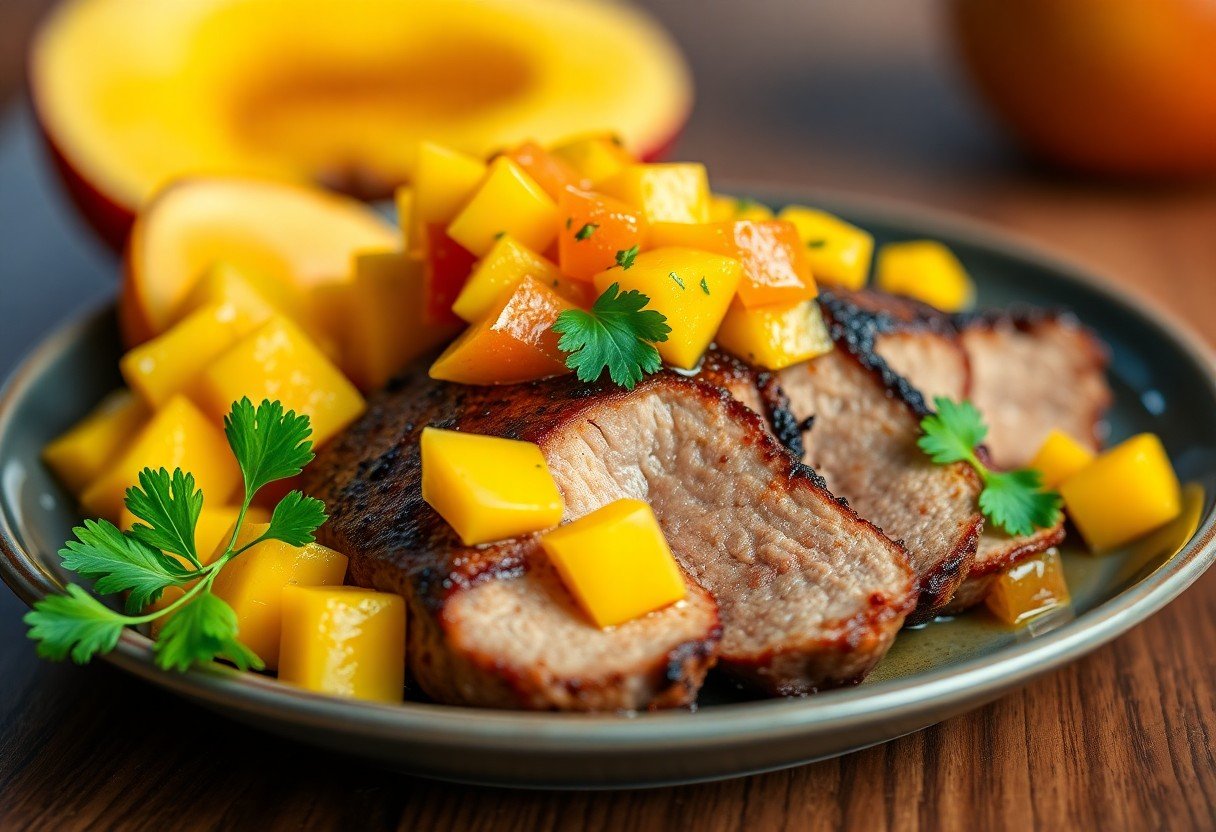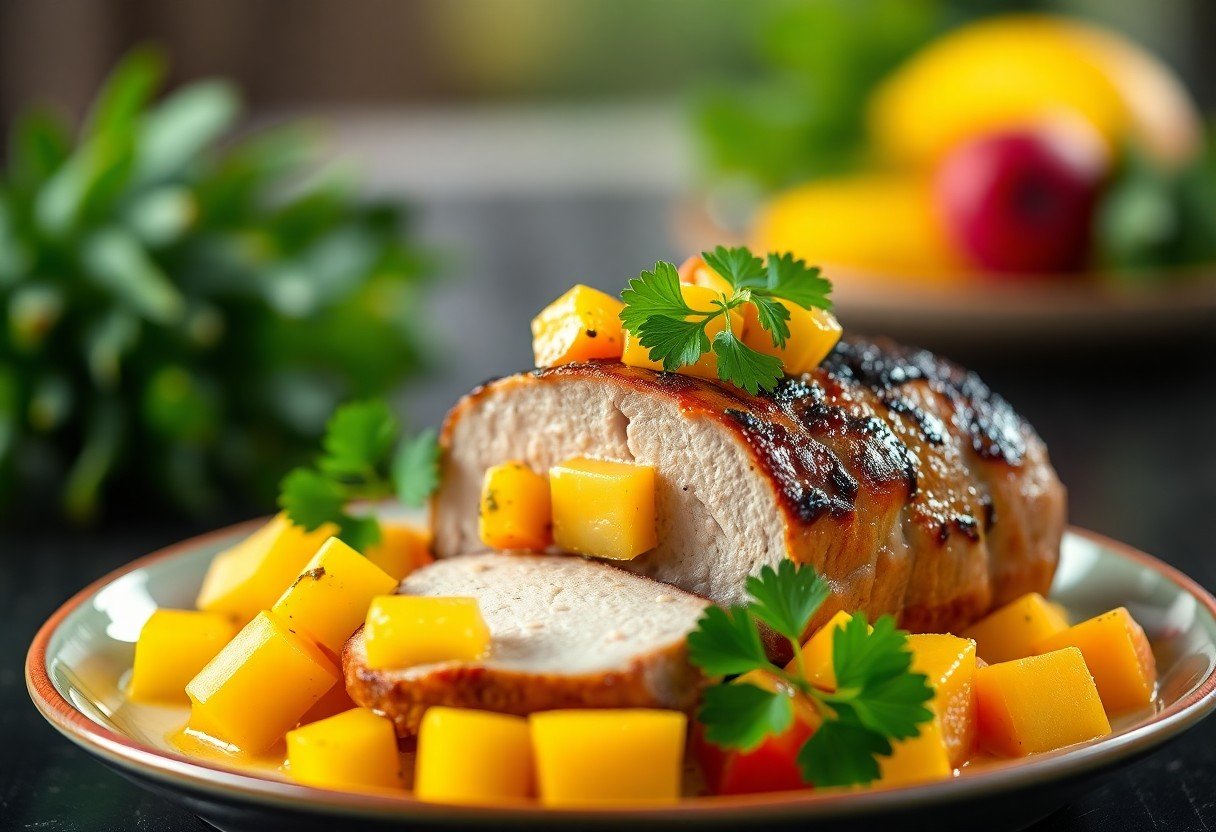Easy Caribbean Pork Tenderloin with Mango Salsa

Unlocking Flavors: The Essence of Caribbean Cuisine
The Vibrancy of Ingredients
The allure of Caribbean cuisine lies in its vibrant ingredients, which reflect the rich tapestry of cultures within the region. Your dishes will often burst with color and flavor—think juicy mangoes, fresh cilantro, and fiery Scotch bonnet peppers. Each element plays a role in creating a symphony of tastes that are at once refreshing and bold. For instance, using ripe, sun-kissed mangoes in your salsa not only adds sweetness but also complements the savory notes of pork tenderloin perfectly, creating a dish that transports you straight to a sunny beachside grill. This balance is key, as the sweetness of the fruit counteracts the savory spices, bringing harmony to your dinner table.
Embracing Heat and Sweetness
Heat is a defining characteristic of Caribbean food, yet it’s not just about spiciness; it’s also about layering flavors. Incorporating fresh herbs, spices, and citrus enhances your dishes in surprising ways. For your pork tenderloin, consider marinating it in a blend of thyme and garlic, paired with a splash of lime juice to brighten the profile. You may even add a hint of allspice, a staple in Caribbean kitchens, that can elevate the meat’s natural flavor while introducing a rustic warmth. The key is to not shy away from experimenting with different combinations, allowing your palate to explore the rich culinary heritage that each bite embodies.

Choosing the Perfect Pork Tenderloin
Selecting Quality Cuts
Finding a high-quality pork tenderloin can significantly enhance your dish. Look for cuts that are labeled as “all-natural” or “humanely raised,” as these tend to be more flavorful and tender. When browsing your local butcher or supermarket, seek out pork that has a bright pink color and minimal marbling. The right amount of fat, about 1/8 inch, around the edges can add moisture while cooking, but you don’t want excessive fat that can lead to greasiness. The tenderness of pork tenderloin comes from its location on the pig, and it usually weighs between 1 to 1.5 pounds, offering an ideal size for your dinner plans.
Marinade Magic: Crafting Flavor Profiles
A well-crafted marinade can transform your pork tenderloin from ordinary to extraordinary. Begin with a solid base of your favorite acidic component, such as lime juice or apple cider vinegar, which helps tenderize the meat and infuses it with flavor. Combined with oil to coat and flavor the meat, the right balance can include garlic, herbs like cilantro or oregano, and spices such as cumin, all highlighting the Caribbean theme you’re aiming for. For an extra punch, consider adding jalapeños or fresh ginger for a surprising twist.
As you mix your marinade, think about your flavor goals. A touch of brown sugar can caramelize beautifully during cooking, giving you a nice glaze, while soy sauce adds depth and saltiness. For tropical flair, don’t shy away from adding diced pineapple or coconut milk into the mix, tying in beautifully with the mango salsa. The marinade not only adheres to the pork, providing added moisture during cooking, but also brightens the overall flavor, making it a delightful centerpiece for your meal.

Mastering the Cooking Techniques
Searing for Succulence
Searing is a technique that lends a savory, caramelized crust to your pork tenderloin, elevating its flavor and texture. Begin by heating a generous drizzle of oil in a heavy skillet over medium-high heat. As the oil shimmers, it’s time to introduce your seasoned pork. Allow the meat to sear without moving it for about 3 to 4 minutes on each side. This creates that beautiful golden-brown crust, locking in the natural juices. The Maillard reaction transforms the meat’s surface, delivering a depth of flavor that will make your dish truly stand out.
Flipping the tenderloin too soon may disrupt the browning process, so be patient. Use tongs to gently lift the meat and check for a rich color indicating a good sear. Once you achieve that perfect crust, you’re ready to transfer the pork to the oven to finish cooking, laying the groundwork for a succulent main dish.
Roasting to Perfection
After searing, roasting is your next step to ensure even cooking throughout the tenderloin. Preheat your oven to 375°F (190°C), a temperature that provides a steer toward caramelization without overcooking. Place your seared pork in a shallow roasting pan or on a baking sheet lined with parchment paper. This allows for a gentle, even cook that will maintain the moisture within the meat while developing flavorful outer layers.
Using a meat thermometer is an excellent way to achieve the perfect doneness; aim for an internal temperature of 145°F (63°C) for juicy pork that’s safe to eat. Remove the pork from the oven once it reaches this temperature and let it rest for at least 5 to 10 minutes before slicing. This resting period helps the juices redistribute throughout the meat, ensuring each bite is tender and moist.
To check for the ideal doneness while roasting, consider keeping a close eye on the color and texture of the meat. The outside should appear golden and slightly crisp, while the inside will be a pale pink. This visual cue, coupled with the thermometer, guarantees that your pork will emerge from the oven perfectly cooked—an impressive highlight on your dinner table. With these techniques, you’ll master the art of cooking pork tenderloin that not only looks stunning but tastes even better with your fresh mango salsa.
The Tropical Symphony: Creating Mango Salsa
Fresh Ingredients That Make a Difference
Your mango salsa will shine when you select only the freshest ingredients. Start with ripe mangoes, as they contribute a vibrant sweetness and a creamy texture that complements the savory notes of the pork. Look for mangoes that yield slightly to gentle pressure and have a fragrant aroma. Pair them with bright red bell peppers and fresh lime juice for that zesty kick. Consider adding chopped red onions for a hint of sharpness, and a handful of fresh cilantro to infuse your salsa with herby freshness. The choice of ingredients directly influences not only the flavor but also the overall appearance, making your dish visually stunning.
Balancing Sweetness and Spice
The key to a memorable mango salsa is mastering the balance between sweetness and spice. While the natural sweetness of the mangoes will be your starting point, a splash of fresh lime juice adds acidity to brighten the flavors. You can turn up the heat by incorporating diced jalapeños or serrano peppers, tailoring the spice level to your personal preference. The interplay between sweet and spicy creates a dynamic flavor profile that enhances your pork tenderloin, ensuring that every bite is a fiesta for your taste buds.
Striking this balance is all about experimentation. Adding a touch of honey can amplify the sweetness if you find your salsa a bit too spicy, whereas a squeeze of lime can cut through sweetness if you want to dial back the tropical fruitiness. Taste as you go, adjusting each ingredient until you achieve that perfect harmony. Aim for a salsa that not only enhances the dish but also offers a refreshing contrast that makes the overall culinary experience unforgettable.

Plating and Presenting Your Culinary Creation
Visual Appeal: Color and Texture
Your pork tenderloin deserves to shine on the plate, and creating visual appeal is all about balance. Start by slicing the tenderloin into medallions, showcasing the tender pink inside that contrasts beautifully with the outer caramelization. Arrange these slices in a fan shape on a vibrant plate. Surround them with your fresh mango salsa — the pop of yellow-orange mango against the rich pork not only adds color but also hints at the explosion of tropical flavors to come. Consider adding a sprinkle of chopped cilantro for an additional green element to enhance the aesthetic.
Texture plays a significant role in making your plate visually appetizing. When you create the mango salsa, aim for a mix of diced ripe mango, red onion, and jalapeño for crunch, and maybe even a few chunks of avocado for creaminess. This combination offers a feast for both the eyes and the palate. The varied shapes, colors, and textures will make your dish look exciting and engage your guests even before they take a bite.
Garnishing Tips for an Extra Zing
A little garnish can go a long way in enhancing your pork tenderloin dish. Fresh lime wedges are a fantastic accompaniment, inviting diners to squeeze a dash of acidity right before they dig in. Not only does this add a splash of color, but the zesty flavor elevates the overall experience, cutting through the richness of the dish. Additionally, dolloping a spoonful of extra salsa alongside the pork not only looks professional but also invites people to enjoy more of that delicious flavor combination.
For an added touch, consider using edible flowers or microgreens. Sprinkling a few over the pork adds sophistication and engages your guests’ curiosity. You might also sprinkle a tiny bit of flaky sea salt or a light drizzle of honey to enhance those vibrant flavors, making the experience truly standout. After making these thoughtful garnishing choices, your dish is sure to impress.
- Pork Tenderloin is beautifully plated with vibrant mango salsa.
- Add color variation with cilantro, lime, and avocado for an inviting look.
- Garnish with lime wedges and edible flowers for a zingy finish.
After ensuring that your dishes are garnished properly, you can enjoy the satisfaction that comes from not just cooking a meal, but transforming it into a visually stunning masterpiece. Simple touches can elevate your presentation to fine dining levels, inviting guests to not only savor the meal but also appreciate its artistry.
- Use fresh lime for zest and microgreens to enhance the visual appeal.
- Flaky sea salt or a drizzle of honey can provide an enticing contrast to the dish.
- Displaying your dish on varied textured tableware adds sophistication.
After perfecting your presentation, you can feel proud knowing you’ve created a dish that is not only delightful in taste but also visually stunning. These garnishing tips transform your easy Caribbean pork tenderloin into a culinary centerpiece that’s bound to be remembered by your guests.
Summing Up
With these considerations, it’s clear that Easy Caribbean Pork Tenderloin with Mango Salsa is a delightful dish that brings together vibrant flavors and straightforward preparation. You can impress your friends and family with a meal that’s not only delicious but also visually appealing, thanks to the bright colors of the mango salsa. The combination of spices and fresh ingredients creates a symphony of taste that transports you straight to the Caribbean, making any mealtime feel special.
Furthermore, this recipe offers you the flexibility to customize the salsa to your liking—you can add a bit more heat with a touch of jalapeño or balance it with a sprinkle of lime juice. This versatility makes it easy for you to suit your palate and those of your guests. So, roll up your sleeves and enjoy the process of creating this mouthwatering dish that is sure to bring smiles to the table!
Easy Caribbean Pork Tenderloin with Mango Salsa
Course: Caribbean Recipes, PorkCuisine: CaribbeanDifficulty: Easy4
servings30
minutes40
minutes300
kcal1
hour10
minutesEasy Caribbean Pork Tenderloin with Mango Salsa—juicy, quick, and bursting with tropical flavors. Ready in under 35 minutes for weeknight dinners or gatherings.
Ingredients
1–1.25 lbs pork tenderloin (480–570g)
2 tablespoons olive oil (30ml)
1 tablespoon fresh lime juice (15ml)
1 teaspoon ground allspice (3g)
1 teaspoon ground cumin (3g)
1/2 teaspoon smoked paprika (1.5g)
1/2 teaspoon salt (2g)
1/2 teaspoon black pepper (1g)
1/4 teaspoon ground cinnamon (0.75g)
2 large cloves garlic, minced
1 ripe mango, diced (about 1 cup, 150g)
1/2 small red onion, finely chopped (40g)
1/2 red bell pepper, diced (60g)
1 jalapeño, finely diced (remove seeds for mild salsa)
2 tablespoons fresh cilantro, chopped (5g)
2 tablespoons fresh lime juice (30ml, for salsa)
Salt and pepper to taste
Directions
- Marinate the Pork:
- In a bowl, mix olive oil, lime juice, allspice, cumin, paprika, salt, pepper, cinnamon, and garlic. Coat pork tenderloin evenly. Let marinate at room temp for 10–30 minutes (or refrigerate up to 2 hours).
- Tip: Quick marinade = big flavor. Make salsa while pork sits!
- Prepare the Mango Salsa:
- Combine mango, red onion, bell pepper, jalapeño, cilantro, and lime juice in a bowl. Season with salt and pepper. Toss well—colors should pop and scent should be fresh and zesty.
- Optional: Chill for 15 minutes to blend flavors.
- Sear and Roast the Tenderloin:
- Preheat oven to 425°F (220°C). Heat a skillet over medium-high. Sear pork on all sides (2–3 minutes per side) until golden brown.
- Transfer skillet to oven; roast 13–18 minutes until pork reaches 145°F (63°C) internal temp and is just a little pink inside.
- Rest, Slice, Top, and Serve:
- Let pork rest 5 minutes before slicing into medallions. Arrange on platter, spoon mango salsa over top, and serve!
- Tip: Resting ensures juicy slices—don’t skip it!
